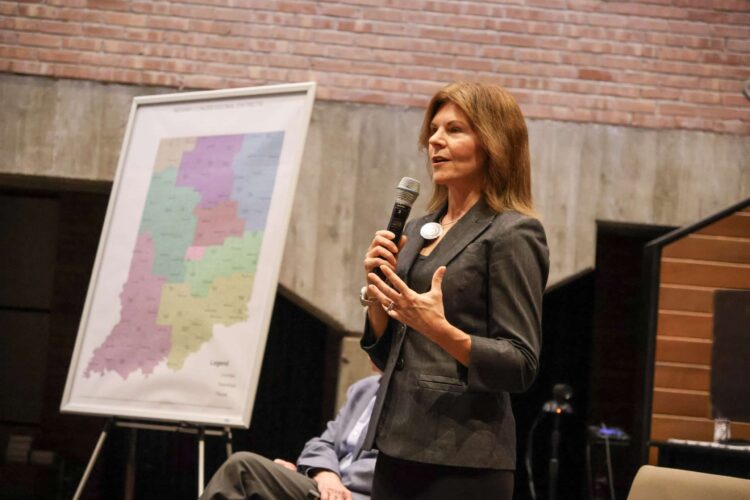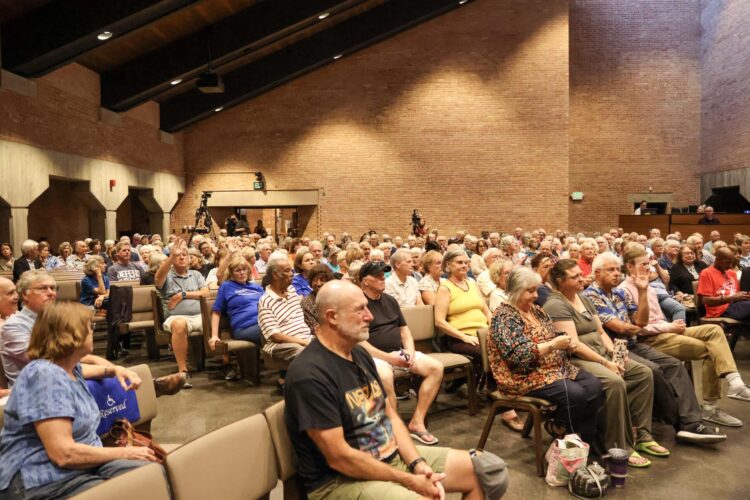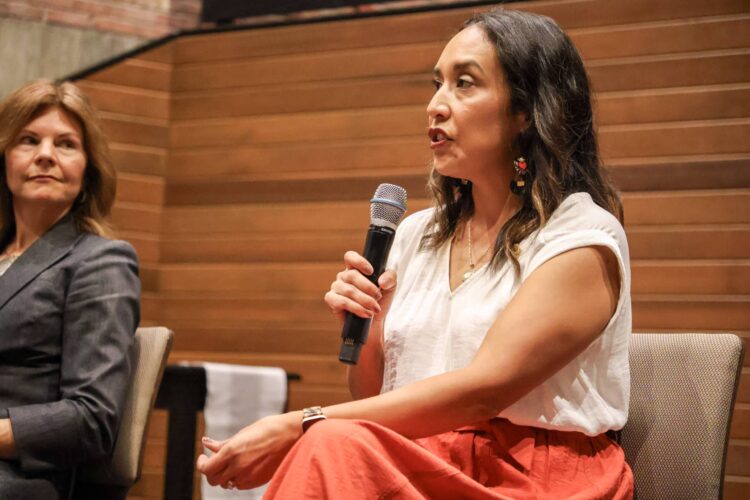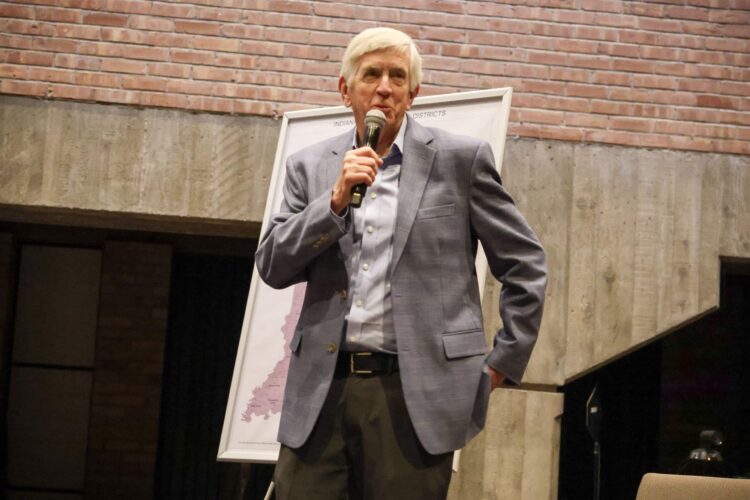
By Marilyn Odendahl
The Indiana Citizen
October 2, 2025
Democratic state lawmakers and voting-rights advocacy groups who oppose a midcycle redistricting believe the silence from the Republican supermajority in the Statehouse is an indication that the marches, the rallies, the phone calls and the letters are having an effect.
Starting with the protest inside the Statehouse on Aug. 7, when Vice President JD Vance arrived to meet with Gov. Mike Braun, House Speaker Todd Huston and Senate President Pro Tem Rod Bray, legislators, citizens, and nonprofits have been relentless in their opposition to redrawing the state’s congressional districts.
Grassroots organizations have held multiple protests at the state capitol building, Democratic representatives and senators have met with constituents at town halls across Indiana, and former South Bend mayor and possible 2028 presidential candidate Pete Buttigieg stood in the atrium of the Statehouse and called mid-decade redistricting “cheating.” Advocacy groups are also holding phone banks and letter-writing parties to encourage Hoosiers to continue contacting legislative leaders and Republican lawmakers.
The Trump administration is pressuring Indiana GOP legislators to redistrict to flip one or both of the state’s blue congressional seats to red. Seven of Indiana’s nine congressional districts are held by Republicans, but District 1 in northwest Indiana and District 7, which covers most of Marion County are held by Democratic Reps. Frank Mrvan and Andre Carson, respectively.
To date, the Republicans have caucused, but they have been tight-lipped about the discussions within the party, their thoughts on redistricting and their plans.

At a “redistricting public listening session” Monday evening, Rep. Carey Hamilton, D-Indianapolis, told the large crowd that she is hopeful redistricting might be derailed because the legislature has, so far, not moved forward. Braun has not called a special session and legislators have not begun or even scheduled a date to start the process of reconfiguring Indiana’s nine congressional districts.
“I think it was about a week ago, Gov. Braun indicated it was going to happen,” Hamilton said of redistricting. “But, we also hear that Republicans are nervous about voting for this and that they may not have the votes yet. So what’s probably happening right now is a lot of arm-twisting. In the meantime, that gives anyone who cares about this issue and is concerned, an opportunity to have your voice heard.”
Hamilton was joined by her Democratic caucus colleagues, Reps. Ed DeLaney, of Indianapolis, and Victoria Garcia Wilburn, of Fishers, at the Monday meeting hosted by St. Luke’s United Methodist Church on 86th Street. The lawmakers, seated at the front of the sanctuary, opened the event by talking about their concerns and frustrations with the Republican push to create new congressional district maps ahead of the 2026 mid-term election.

Overwhelmingly the attendees of the meeting seemed to be just as frustrated and even angry at the prospect of a mid-decade redistricting. Packed into the pews, the crowd groaned when a reference was made to President Donald Trump and applauded when the representatives said having competitive districts is good for the voters and for the state.
Redistricting usually occurs once a decade after the results of the decennial U.S. Census, but the Trump administration is pressing Indiana and other states to redraw their congressional boundaries this year to head off a possible Democratic surge in the mid-term election.
Standing beside a map of Indiana’s nine congressional districts, highlighted in different colors, DeLaney said the goal of the GOP’s effort to redistrict this year was not to grab another seat for the Republicans, but to eliminate the Democratic Party which routinely gets about 40% or 45% of Hoosiers’ votes every election. He then pointed out that Democrats in the legislature have no ability to block any part of a special session because they are a superminority.
However, DeLaney said the listening session demonstrated some of the tools the opponents of redistricting have available to stop the process. The lawmakers have to work hard and stay focused, he said, while constituents have to vote and register their friends and family to vote.
Also, DeLaney said, “Every one of us has to decide the following very difficult thing: … Some of us are going to have to agree to try to work together on the common goal of saving democracy and representative government.”
Common Cause Indiana conveyed a similar message during a redistricting update webinar Tuesday evening. Along with an overview of the redistricting push in Indiana, the virtual event included a review of redistricting in Texas, which was the first state to redraw its congressional boundaries this year, and a tutorial of Section 2 of the Voting Rights Act, which prohibits voting practices that discriminate against minorities, and racial gerrymandering.
People from across the state tuned in to the online rally and asked questions about the Republican lawmakers who have come out against redistricting, the estimated cost of a special session, and whether a lawsuit could block any new maps from being used in next year’s election.
One attendee wanted to know the consequences of the state’s maps being redrawn mid-decade. Julia Vaughn, executive director of Common Cause Indiana, replied, “You would be undoing what voters have selected. For many generations in northwest Indiana and in Indianapolis, voters have elected Democrats and so this is a deliberate attempt to undo what the voters have done for a long time.”
However, like Hamilton, Vaughn noted the supermajority has not begun the process to redistrict. She said the delay is clearly coming from the State Senate, where likely at least half of the 40 GOP senators are not supportive of redoing the maps. While the threats from what she called “dark money entities and various politicians” to mount a primary challenge against any reluctant Republicans created a lot of fear in the Indiana House, because all of the members will be on the 2026 ballot, Vaughn said that effort at intimidation has not been as successful in the Indiana Senate, since only half are vying for reelection.
Vaughn also attributed the hesitancy among some Republican legislators to Hoosier traits like being obstinate, unwilling to follow the crowd and resistant to the demands from people outside Indiana. Moreover, Hoosiers particularly value fairness.
“So I think asking Republican legislators to blatantly cheat, which is what they would be doing, just doesn’t sit well with a lot of these legislators and that’s a good thing,” Vaughn said, adding that Braun has called the legislature “old fashioned” because it follows the rules. “Thank goodness that many of our Hoosier legislators are old-fashioned and believe that you shouldn’t change the rules of the game just because you fear you might lose.”
Vaughn implored the people attending the webinar to exert some of their own pressure on Republicans by contacting the governor and legislative leaders. Also, she encouraged the attendees to contact GOP representatives and senators to thank those who have come out against redistricting and to convince the others to oppose redrawing the maps.
Since the focus of any reconfiguring would be on the Democrat-leaning districts in northwest Indiana and Marion County, Vaughn said the constituents in those areas are aware of what is going on at the Statehouse. She told the attendees to talk to their family and friends to make sure people outside of those areas know what is happening.
Cindy Douglass, one of the many who tuned in to the webinar, expressed her frustration at the gerrymandering that has already taken place so those in the Democratic Party can no longer rely on the old norms to fight back.
“All my life, I’ve been told… ‘Well, if you don’t like what’s going on, your option is go to the polls and vote,’” Douglass said. “That’s not a thing to do anymore. As progressives, what do we do it we don’t like what’s going on?”
The crowd at the Monday listening session asked the three lawmakers a variety of questions about redistricting, including what would be the deadline for redrawing the maps in time for the 2026 mid-term election (DeLaney speculated they probably would have to be done by “quite early in December”) and how many votes would be needed to pass new maps (Hamilton said a simple majority of 51% in each chamber).

Although the Republicans in the legislature, who hold a supermajority, have complete control over when and how to redraw the congressional districts, Garcia Wilburn told the attendees that the concerns about mid-decade redistricting reach across party lines.
“Our convening today has no political affiliation,” Garcia Wilburn said. “Our convening today is thinking about what is right, what is wrong, what is constitutional and what isn’t and how we’re going to meet this moment in history.”
Still, one question from the audience seemed to acknowledge the uphill battle the opposition is facing. Referring to the inability of Democrats in the Statehouse to stop Republicans, one attendee asked, “What can we do about it?”
Hamilton suggested using the words of the GOP legislators against them. She said when the state legislative and congressional district maps were redrawn in 2021 using 2020 census data, the Republicans in the Statehouse declared them to be fair.
“It’s not easy for them to vote against (these maps) now,” Hamilton said. “Help them say, ‘Hell no.’”
Many people in the audience passed along information about phone banks and marches. They, too, encouraged others to contact the legislators and try to convince the elected officials to oppose a mid-cycle redistricting.
Asked whether redrawing districts to make Indiana’s congressional districts all Republican could backfire, Hamilton answered, “Let’s hope so.”

DeLaney explained the backlash against redistricting could extend beyond the individual lawmakers and tarnish the entire Republican Party.
“This will be the most visible vote they will ever take,” DeLaney said. “So if you get 60 and 70 of them taking that vote, we can attack our opponents as a party. We don’t need to be subtle… We can just say as a group, they need to go.”
Dwight Adams, an editor and writer based in Indianapolis, edited this article. He is a former content editor, copy editor and digital producer at The Indianapolis Star and IndyStar.com, and worked as a planner for other newspapers, including the Louisville Courier Journal.
The Indiana Citizen is a nonpartisan, nonprofit platform dedicated to increasing the number of informed and engaged Hoosier citizens. We are operated by the Indiana Citizen Education Foundation, Inc., a 501(c)(3) public charity. For questions about the story, contact Marilyn Odendahl at marilyn.odendahl@indianacitizen.org.